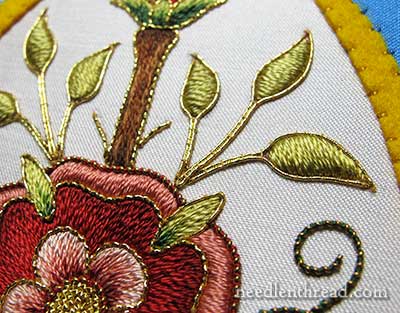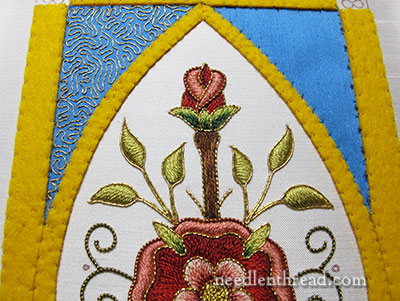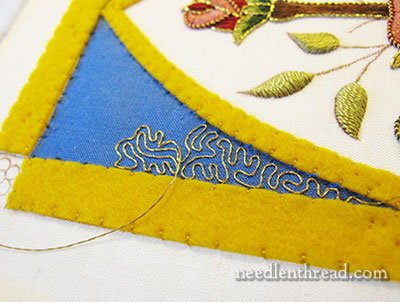The other day when I showed you my failed attempt at the gold lattice work on the blue silk fabric on the Mission Rose project, most of you guessed pretty quickly that I’d fall back on vermicelli goldwork over the blue silk. And I did!
Vermicelli is an appropriate name for this meandering, worm-like technique involving a fine couched thread. I used it extensively in the Marian Medallion Project as a background for the whole medallion. It served really well in that project for securing the flat silk used in the background. I almost regret not using flat silk in the corners on the Mission Rose.
But the technique works equally as well over fabric, too. And so, I opted for it – much better than the lattice work, methinks.

But did I ever show you the goldwork treatment on the smaller leaves on the rose part of the design? Here it is!
It’s smooth gold passing thread (size 5), couched double along the stems and then, right at the base of the leaf, it splits into single lines, wraps up the sides of the leaf, and the thread ends are taken to the back at the tip of the leaf.

And here’s the top of the design, with the first corner of vermicelli worked. It was a cloudy, dark day, so the gold isn’t gleaming at its best in this shot, but the gold does gleam quite a bit!

Here, you can see the vermicelli meandering along. I’m using a thread called Elizabethan twist, which is a very fine, two-ply slightly twisted goldwork thread, and I’m couching it with YLI 100 wt silk sewing thread that’s been run through beeswax.
Elizabethan twist takes the curves in this kind of work really well. This vermicelli technique is not limited to goldwork, though. You can work this technique with any type of thread that you want to couch in squiggly lines. The idea is that the thread keeps turning and meandering around itself, filling in an area without ever overlapping or running back into itself.
If you’re wondering about the frames – the marquise-shaped central frame and the outer rectangle – they will be worked in different types of couched gold, completely covering the felt. I have a few ideas brewing, but I need to test them before I’m absolutely certain about which gold thread I’ll use. Soon as I know, you’ll know!
But first thing’s first – must finish all four corners. Fingers crossed for this weekend! I’m dying to get to the frames!
I really appreciated all your input and good ideas expressed in the last article on the failed lattice! If you have any questions, comments, or suggestions here, I’m all ears, too! Have your say below!







Yes, I think the vermicelli is much better suited to this design than the lattice was. This is looking really lovely and I can’t wait to see the goldwork go on the frames.
Dear Mary
Oh it looks beautiful with the Vermicelli gold work I love Elizabethan twist it’s so easy to work with I used on the Agnes Dei project and love it. The whole projectIt looks so professional and I love the goldowork on the leaves. I can’t wait to see what gold you use for the yellow felt.
Regards Anita Simmance
Hi Mary
Just wondering why you felt you had to ‘fill in’ the blue area at all, as you are going to surround the project in gold anyway. I thought the rose ‘window’ effect was intensified with the sky blue behind it, pure and plain. The vermicelli is nice, too, but something less busy (obviously not the lattice)might have been better. But what do I know? I’m relatively new to your wonderful website (recommended by my daughter, bless her) and each day I learn something new. Many thanks for your guidance.
Paula
Absolutely scrumptous!! What are your plans for it? Framing or gift ???
A great improvement! I think the vermiclli work tones down the blue and the gold helps the blue relate to the central motif. I’m really looking forward to seeing how the frame is worked.
I agree the vermicelli is better than the lattice work would have been. One thing I’ve always wondered about vermicelli – how do you keep the coverage even across the space, while avoiding a “dead end”? If I were trying to do it, I’d have to draw it all out in advance just to make sure I didn’t work myself into a corner, or end up with a lop-sided design! Is it just experience with the technique, or is there a trick to it?
Mary in MN
Hi, Mary – Really, it isn’t difficult. If you try it with a practice thread on scrap fabric, you’ll probably get the hang of it pretty quickly. The key is just to look ahead of where you’re going and … keep going! As long as the threads are more or less spaced consistently as they wind around each other and turn back and forth, it will turn out looking fine. It is pretty easy to keep yourself out of a corner, because you can always turn around if it looks like things are going to get too tight. But the key, really, is to practice it at least once on practice fabric, within a specific space. Drawing it out ahead of time is problematic – the gold thread is really very fine, so covering a line would be difficult. ~MC
Ah – of course. So simple a solution and it looks so wonderful.
Oh, how I love this site! Mary, you have such a wonderful teaching ability. I wish your website closeups were clickable to BIG, BIG!!! pictures so I could see how you couch the gold thread, etc. With your beautiful work, detail is everything. You are definitely the guru of stitching!
Bev in Utah
I have always loved the vermicelli look for filling in spaces. I always used it on the tops of my bride and groom’s cakes when I was decorating. I usually put the message and design into an oval and then used the vermicelli on the top of the rest of the cake ( these were sheet cakes) to draw the eye in toward the disign. It really made the rest of the cake and message stand out. I think it does much the same thing when you use it as you are in the Mission Rose project. It almost seems like a “mat” that would be used to frame a picture. Your work is so, absolutely, beautiful. You truly are and artist with thread! Yours is the first email I open whenever I log on and i’m still perusing your archives and Q&A’s. I never tire of being on your blog and looking at your work and instruction videos. I do hope you will make an ebook of the Stitches & Colors & Letters post from last Thursday. It gave me so much inspiration for the stitching i’ll do on my crazy quilt. I’m feverishly working on getting some squares ready for the decorative stitching. Deonia in Florida
Mary, this is so perfect! Not that I ever doubt your decision making, you were right to not use the lattice. This is going to look so wonderful when it’s done. Thanks for sharing your talent.
S-o-o-o glad to see this worked out Mary. I was holding my breath regarding your blue fabric–cutting gold off silk isn’t for the faint of heart. You must have a very steady hand & good eyesight!
Boring beyond belief, will be so glad when its over and the interesting Mary returns!!!!!!!!!!!!!
Mary…this looks a bit like “stippling” that I do with my sewing machine on my quilts! I love how “stippling” on my quilts is meandering…and yet it makes different quilt blocks “connect” together! So…is this like “stippling”?
Hi, Bonnie – stippling is usually done with dots, rather than meandering lines. They’re both filling techniques, but one involves dots and the other involved meandering lines. -MC
Love that! It looks dainty yet refined. And the gold beading tones the blue into a teal-ish color does it? It seems really pulled together and the whole thing looks great.
I didn’t like the blue background at all but when you added the vermicelli, it is magnificent!
I like the Vermecili better than the lattice work. It fits the design of this piece better. The technique is basically stippling in the quilting context.
Aha! Now I know the name of that beautiful technique. It really looks stunning and now I want to give it a try to see if I can stitch it as well as you do, Mary! (I won’t do as well but a girl can dream and at least I can always look at your work for inspiration.) 😉
Yes! This begins to work! I’m starting to realize that the gold work is what will dominate this piece when it is finished, and the ’till now’ garishness of the coloration is going to be submerged in a splendiferous explosion of bling! I also am suddenly seeing that the stark white of the main background is part of what makes the colors so bright, whereas the colors of the original ‘inspriation piece’ were more muted in every way.